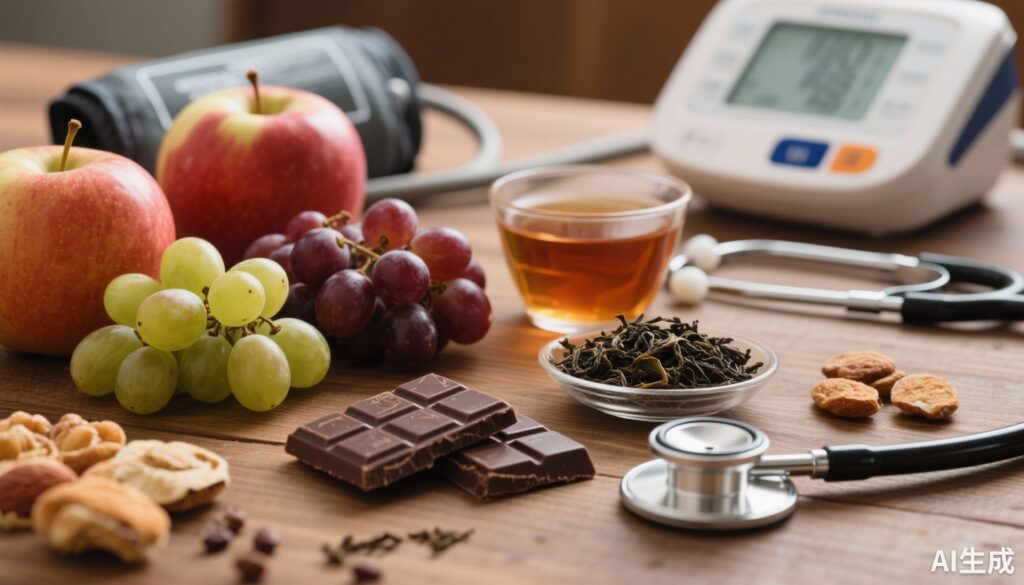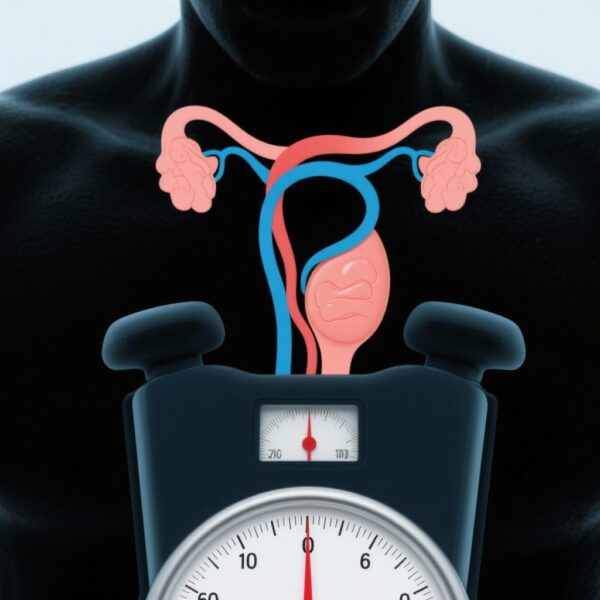Highlight
– Flavan-3-ol-rich interventions, including cocoa, tea, grapes, and apples, reduce both office and 24-hour ambulatory blood pressure in diverse populations.
– Blood pressure reductions are more pronounced in individuals with elevated or hypertensive baseline blood pressure.
– Flow-mediated dilation, a measure of endothelial function, improves significantly following both acute and repeated flavan-3-ol intake, independent of blood pressure changes.
– The safety profile of flavan-3-ol interventions is favorable with minor adverse events reported.
Study Background
Cardiovascular disease (CVD) remains the leading cause of mortality globally, with hypertension as a substantial modifiable risk factor. Despite the availability of pharmacotherapy and lifestyle recommendations, the global burden of elevated blood pressure continues to grow. Flavan-3-ols, a class of flavonoids predominantly found in foods such as cocoa, tea, apples, and grapes, have emerged as promising nutraceutical agents due to their vascular benefits including blood pressure lowering and enhancement of endothelial function. However, they have yet to be integrated into mainstream cardiovascular preventive strategies. This comprehensive meta-analysis aims to synthesize evidence from randomized controlled trials (RCTs) evaluating the effects of flavan-3-ol-rich interventions on blood pressure and endothelial function across heterogeneous populations.
Study Design
This systematic review and meta-analysis was conducted according to a pre-registered protocol (PROSPERO: CRD42023454691). The authors performed an extensive search of PubMed for RCTs published between 1946 and March 2024 assessing the impact of flavan-3-ol-rich foods, beverages, or supplements on blood pressure (both office and 24-hour ambulatory) and flow-mediated dilation (FMD), a validated measure of endothelial function. The analysis included 109 publications encompassing 145 RCTs with a total of 5,205 participants. Interventions studied delivered an average dose of 586 mg (95% CI 510–662 mg) of total flavan-3-ols, including epicatechin, epigallocatechin gallate (EGCG), and other commonly consumed sources such as cocoa products, tea, grape extracts, and apples. Both acute and chronic effects were assessed, with subgroup analyses by baseline blood pressure, presence of cardiovascular and metabolic comorbidities, study duration, and epicatechin dose.
Key Findings
The meta-analysis demonstrated that chronic, repetitive consumption of flavan-3-ol-rich interventions produced significant reductions in both office and 24-hour ambulatory blood pressure. Specifically, office systolic and diastolic pressures decreased by an average of –2.8 mmHg (95% CI –3.9 to –1.7) and –2.0 mmHg (95% CI –2.6 to –1.3), respectively. Corresponding reductions in 24-hour ambulatory blood pressure were –3.7 mmHg (95% CI –5.8 to –1.6) systolic and –2.6 mmHg (95% CI –4.5 to –0.8) diastolic.
Importantly, these effects were more pronounced in participants with elevated baseline blood pressure or clinical hypertension. In this subgroup, office systolic and diastolic pressure reductions reached –5.9 mmHg (95% CI –10.0 to –1.8) and –2.7 mmHg (95% CI –4.4 to –1.0), respectively. Similarly, 24-hour ambulatory blood pressure reductions were –6.8 mmHg systolic and –5.1 mmHg diastolic, although confidence intervals were wider in these subsets. Meta-regression analyses corroborated an inverse linear relationship between baseline blood pressure and the magnitude of blood pressure reduction, indicating greater benefit in hypertensive individuals. Notably, no significant effect modification by the proportion of participants with cardiovascular disease or diabetes, nor by study duration, was observed.
Dose-response analysis revealed a significant association between higher epicatechin doses and blood pressure lowering effects in cocoa product studies, suggesting a potential mechanistic component specific to this subclass of flavan-3-ols.
Regarding endothelial function, flow-mediated dilation improved significantly after both acute and chronic consumption of flavan-3-ol-rich foods (+2.0% and +1.7%, respectively), an effect independent of blood pressure changes. This improvement in endothelial function underpins the vasculoprotective potential of flavan-3-ols beyond hemodynamic modulation.
Safety data across the pooled studies reported minor adverse events with a low incidence rate of 0.4%, indicating excellent tolerability.
The analysis revealed considerable heterogeneity among individual study outcomes (I2 > 50%), which was not accounted for by typical moderators such as population characteristics or intervention specifics. This heterogeneity limits the overall evidence quality rating to ‘moderate,’ suggesting the need for cautious interpretation.
Expert Commentary
The findings presented align with a growing body of literature recognizing the cardiovascular benefits of polyphenol-rich diets. The observed blood pressure reductions, while modest, are clinically meaningful at a population level given the well-documented dose-response relationship between blood pressure and cardiovascular risk. The enhanced effect in hypertensive populations highlights a valuable niche for targeted nutritional interventions.
Mechanistically, flavan-3-ols may exert beneficial effects via improved nitric oxide bioavailability, antioxidant actions, and anti-inflammatory pathways that collectively enhance endothelial function. The demonstrated improvement in flow-mediated dilation supports these mechanisms. The dose-dependent response to epicatechin warrants further exploration to optimize intervention formulations.
Limitations include the heterogeneity of included studies, variability in flavan-3-ol doses, and diversity in baseline participant characteristics. Additionally, the predominance of short-to-medium term trials limits knowledge on long-term cardiovascular outcomes directly attributable to flavan-3-ol intake. Current guidelines have yet to incorporate flavan-3-ols explicitly for cardiovascular risk reduction, though emerging evidence may prompt reevaluation.
Conclusion
This comprehensive meta-analysis provides robust evidence that flavan-3-ol-rich foods and supplements significantly lower blood pressure and improve endothelial function across diverse populations, with amplified benefits in individuals with hypertension. These findings support the integration of flavan-3-ol-containing dietary components such as cocoa, tea, grapes, and apples as accessible, safe adjunctive strategies for cardiovascular prevention. Future large-scale, long-term RCTs should clarify optimal dosing, formulation, and clinical outcomes to inform guidelines and public health recommendations.
Funding and ClinicalTrials.gov
The study was supported by multiple academic and industry collaborations, as detailed in the original publication. The meta-analysis was registered prospectively in PROSPERO (CRD42023454691). No new clinical trial data were generated.
References
Lagou V, Greyling A, Ferruzzi MG, Skene SS, Dubost J, Demirkan A, Prokopenko I, Shlisky J, Rodriguez-Mateos A, Heiss C. Impact of flavan-3-ols on blood pressure and endothelial function in diverse populations: a systematic review and meta-analysis of randomized controlled trials. Eur J Prev Cardiol. 2025 Oct 10;32(14):1322-1334. doi: 10.1093/eurjpc/zwaf173. PMID: 40126033.
Additional relevant literature:
– Ried K, Sullivan TR, Fakler P, Frank OR, Stocks NP. Effect of cocoa on blood pressure. A meta-analysis. Am J Hypertens. 2010;23(1):97-103.
– Hooper L, Kay C, Abdelhamid A, Kroon PA, Cohn JS, Rimm EB, Cassidy A, de Belder AJ, Gray A, Witkowski V, et al. Effects of chocolate, cocoa, and flavan-3-ols on cardiovascular health: a systematic review and meta-analysis of randomized trials. Am J Clin Nutr. 2012;95(3):740-751.
– Schwingshackl L, Hoffmann G. Flavonoids and cardiovascular risk: a systematic review and meta-analysis of prospective studies. Br J Nutr. 2015;114(5):704-716.



